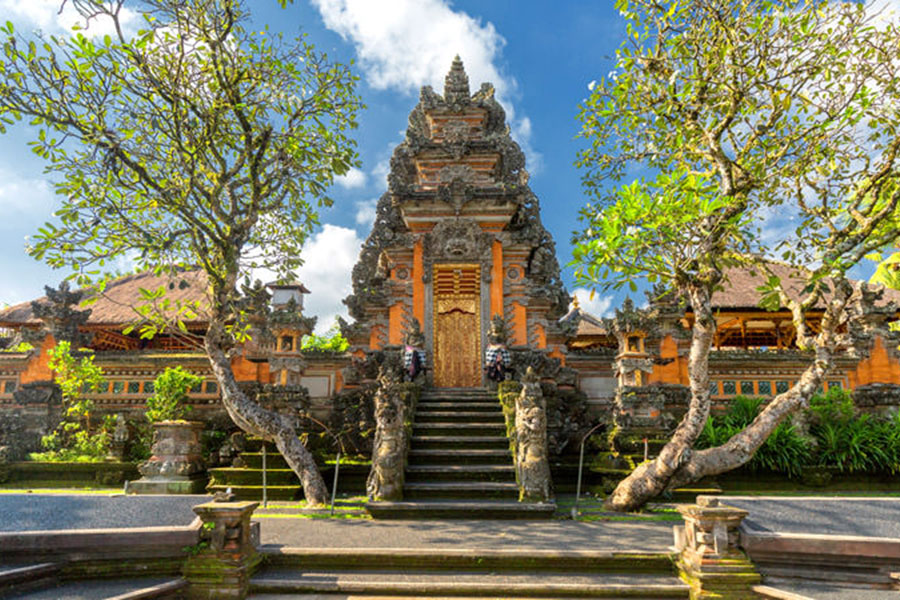UBUD ROYAL PALACE
BALI UBUD ROYAL PALACE IS UBUD KINGDOM PALACE WITH A BEAUTIFUL TRADITIONAL HOUSE AS A RESIDENCE OF UBUD KING

Puri Saren Ubud, also known as Ubud Royal Palace, is the Royal Palace of Ubud that features a beautiful traditional Balinese house as the residence of the King of Ubud. Located in the center of Ubud Bali with a traditional art market in front of it, the palace was founded by Ida Tjokorda Putu Kandel during his reign from 1800 to 1823. Ubud Royal Palace is the center of art and cultural activities, while the traditional market is a symbol of the local economy. Within the palace complex, there is a large Wantilan, or auditorium, as a meeting place, as well as banyan trees for shade during the day. The traditional market is a place of community economy that always coexists with the palace as a center of arts and cultural activities. This shows the interconnected dynamics of community and royal life.
If you visit Ubud Royal Palace, here’s what you need to know :
- Ubud Village History
- Ubud Village Name History
- Kingdom Period in Bali
- Establishment Kingdom in Ubud Village
- Construction of Puri Saren Ubud
- Beginning Ubud Village Famous
- Puri Saren Ubud is Ubud Palace
- What You Can See at Ubud Palace
- Location Ubud Palace
- Traditional Dance at Ubud Palace
- Ubud Palace Facilities
Ubud Village History
Before reading more, it is important to know the history of Ubud Village. In the 8th century, there is an ancient lontar record that tells the story of the beginning of Ubud Village. The story begins with Rsi Markandeya visiting the island of Java before arriving on the island of Bali. On the island of Java, he received a revelation about Mount Agung, which has 5 types of powerful metals. After arriving in Bali, Rsi Markandeya went straight to Mount Agung, which is now Besakih Temple. There, he felt strong energy in Campuhan Village, which is now the location of Gunung Lebah Temple. Rsi Markandeya stayed in Ubud and taught religion, irrigation systems, terraced agriculture, and social systems through the Banjar community organization, which still plays a role in Bali today. That is the story of the beginning of Ubud Village, which was founded by Rsi Markandeya and became a center of religious teaching, agriculture, and social organization.
Ubud Village Name History
The history of Campuhan Village in Ubud is highly respected by the Balinese because Rsi Markandeya first came there and taught about religion and other matters. In the past, Campuhan Village was also known for having many medicinal plants used in traditional medicine. That is why the name “Ubud” comes from the word “Ubad” which means medicine. Campuhan Village is rich in ancient medicinal plants, and that’s how the name “Ubad” gradually changed to “Ubud”. When visiting Ubud, it is recommended to visit Campuhan Village, as there are various interesting tourist destinations such as Campuhan Ridge Walk, Campuhan River, and others that will definitely add fun to your trip to Ubud.
Kingdom Period in Bali
The royal period in Bali began in the 15th century, when there was a massive migration of nobles from Java to Bali Island. They established the Gelgel Kingdom in Klungkung Regency, which provided protection to the nobles and accommodated the caste system that existed in Bali. Over time, many new kingdoms emerged in Bali in the 17th century, and many Puris were built as residences for the nobles. In this era, there were also wars between kingdoms competing to expand their territories and face other conflicts on the island.
The History of The Establishment Kingdom in Ubud Village
During the wars and power struggles between the kingdoms of Bali in the 17th century, a prince from the Gelgel Kingdom of Klungkung was sent to Sukawati Village with the mission of establishing a kingdom that had a magnificent palace to cover the power in the Gianyar region. The process of building the royal palace in Sukawati involved many artists from various regions who were invited to Sukawati, the result was the stunning appearance of the palace at that time. After the construction was completed, many artists chose to live in Sukawati, making it the center of Bali’s arts, including painting, sculpture, music, and more. Along with the successful construction of the palace, soldiers were sent to Ubud to maintain security as a conflict between two cousins in the Padang Tegal and Taman Ubud areas caught the attention of King Sukawati. He sent two of his brothers to mediate and establish a kingdom in Ubud: Tjokorde Ngurah Tabanan established a kingdom in Peliatan, and Tjokorde Tangkeban established a kingdom in Samabahan. The aim was to protect Ubud from conflict. Tjokorde Ngurah Tabanan was assisted by the King of Mengwi to increase the population of Ubud, which in turn stimulated the economy and made Ubud famous in its time.
Although the Dutch colonial government replaced the ancient Balinese feudal system more than eighty years ago, the Tjokordas still play a special role in Ubud society. They assume many leadership roles, both sacred and secular, and are important figures in the local business community, arts institutions, and professional circles. While no formal power is automatically given to an individual based on their puri background, the royals of Ubud have been respected for generations because of their descent. In addition, some of them are also respected for their immense wealth.
The Tjokordas no longer physically represent the state. They are ordinary citizens with similar concerns as other citizens, coupled with additional responsibilities and concerns. The puris in Ubud are therefore essentially family homes and have not been turned into museums or public tourist attractions. Although some of them have beautiful traditional architecture, none of them have a very old history. In fact, most of the palaces are relatively new. The oldest puri in Ubud is located slightly east of Ubud Dalem Temple, above the main road. Unfortunately, this palace collapsed due to an earthquake at the beginning of this century, leaving only the ruins of the foundations scattered about the place.
Construction of Puri Saren Ubud
During the reign of Ida Tjokorda Putu Kandel (1800-1823), Puri Saren Agung, or Ubud Royal Palace, was established, which involved many Ubud artists to build. It served as a place for the preservation of traditional Balinese culture, such as dance and literature, and as the residence of the King of Ubud. After the death of Ida Tjokorda Putu Kandel, his son, Tjokorde Putu Sukawati, led the government (1823-1850). During this time, Ubud Village flourished in many areas, especially in the fields of painting, carving, and dance, for which it has long been famous.
Beginning Ubud Village Famous
In the early 1930s, Ubud Village began to gain popularity abroad as many tourists came to visit. Ubud Village was ready to receive tourists at that time, especially thanks to the business confidence of Tjokorde Gede Agung Sukawati, who spoke fluent English and Dutch. He established a small guest house and, together with his brother, Tjokorde Raka Sukawati, invited famous composers and artists such as Walter Spies to live and work in Ubud. This decision brought Ubud Village to great prominence abroad, and soon after, many famous figures began to come to Ubud, such as Rudolf Bonnet and Williem Hofker, who brought modern painting there. The village became a magnet for renowned artists like Noel Coward, Charlie Chaplin, H.G. Wells, and even famous anthropologists like Margaret Mead. In 1936, Tjokorde Gede Agung founded a painters’ association that included local and foreign artists such as Spies and Bonnet, with help from American composer Colin Mcphee, who had built a house along the stunning Sayan Ridge. This achievement reinforced Ubud’s reputation as the center of Bali’s cultural activities. In addition, Ubud is also an important part of the Gianyar places of interest, which are known for their natural beauty and rich cultural heritage.
Puri Saren Ubud is Ubud Palace
Ubud Royal Palace, also known as Puri Saren Ubud, has been the center of “royal town” life in Ubud for more than a century. Royal families who have the title “Tjokorda” or “Agung” still live in traditional palaces called “Puri”. However, it is important to remember that not every building called “Puri” is a royal palace, as the use of this word has become more widespread in recent times. In Ubud, there is not just one puri, but many puris, mostly located around the main crossroads near the Ubud market. There are also other “royal” towns in the Ubud area with their own palaces, which are generally closely related to Tjokorda Ubud. This relationship is maintained through marriages and family ties among the descendants of the princes of Sayan, Pejeng, Singapadu, Peliatan, and Payangan Puri. Although the ancient Balinese feudal system was replaced by Dutch colonial rule more than eighty years ago, the Tjokordas still have an important role in Ubud society. They hold many leadership roles, both sacred and secular, as well as being key figures in areas such as local business, the arts, and professionalism. Although no formal power is granted to them simply because of their puri-born status, Ubud’s nobles are still respected for their heritage as well as their wealth. In pre-colonial times, Bali’s puris were centers of art, music, dance, and literature, and this tradition continues to be maintained by the puris of Ubud. They act as custodians of traditional culture and also develop artistic activities in the region, providing great benefits to locals and incoming tourists alike.
What You Can See at Ubud Palace
Ubud Royal Palace is a historical building that tells the story of the reign of the kings of Ubud in ancient times, and it still stands strong and well-preserved today. When visiting Ubud Village, you can see its original characteristics preserved from ancient times, including the stunning stone carvings. Ubud Palace has become one of the most famous tourist destinations in Ubud Village because of the uniqueness and beauty of the building. There are many interesting things you can find in Ubud Palace, adding to your adventure experience in Ubud Village.
- Wantilan: In front of Ubud Palace, there is a large wantilan that serves as an open space for resting and is also used for events such as traditional religious dance performances in Ubud Village using gamelan (traditional Balinese musical instruments).
- Entrance: The first thing you see is the very grand entrance with its historic design, reliefs, and carvings of high historical significance. The slightly embellished color of the red bricks adds to the luxurious feel of this entrance.
- Statue: Next to the entrance is an artistic statue, giving a Balinese welcome with a frangipani tree. You can capture this moment as you enter the door with the statue on your right and left.
- Kori Agung: In the center is the magnificent Kori Agung, made of dark red bricks, with wooden doors decorated with gold paint, making it beautiful. Many tourists take pictures in front of Kori Agung for its breathtaking views and Instagram-worthy photos.
- Throne: Through the door to the left of Kori Agung, you will reach the second courtyard with the ancient royal throne of Ubud inside the building. Inside, there are two throne chairs that were used by the ancient kings of Ubud when they ruled during the royal era.
- Gamelan: Apart from the throne, there is also a complete gamelan that was once used by the kingdom for religious ceremonies and dance performances. Gamelan is a traditional Balinese musical instrument that is important in Balinese culture for religious ceremonies and other performing arts.
Location Ubud Palace
The location of Ubud Royal Palace is indeed very strategic, located in the center of Ubud city which is close to Ubud Market. It is also within easy reach of popular tourist destinations such as Ubud Monkey Forest and Saraswati Temple. If you are coming from Kuta, the travel time is about 2 hours, and with the help of Google Maps or directions at the crossroads, you can easily find Ubud Royal Palace. If you want to be more comfortable without having to drive yourself, Bali Exotic Tour is ready to take you with Hire Car and Driver services at affordable prices and quality, which will certainly make your trip more enjoyable.
Traditional Dance at Ubud Palace
Besides being a tourist destination for historical buildings, Ubud Royal Palace also offers mesmerizing traditional dance performances. Professional dancers present Legong dances that take stories from the Mahabharata and Ramayana. This performance is held in the afternoon from 19.30 p.m. to 21.00 p.m. in front of Kori Agung in Ubud Palace. This dance performance is very enchanting and beautifully presented by the dancers, bringing you into the story being told. To watch this performance, it is advisable to arrive early and buy tickets at the counter in Ubud Palace, as the venue is not too big, and tickets can run out if you arrive late. Watching a traditional dance performance in the center of Ubud is a special experience, where the beauty of the dancers’ movements will draw you into the emotions of the story being told.
Ubud Palace Facilities
Ubud Palace is one of the most popular tourist destinations in Ubud, with complete facilities. It has a parking area on the north side of the road, and you can also park at the Ubud market and walk to Ubud Palace as it is centrally located and busy. There are also toilet facilities at the Wantilan in front of the Ubud Royal Palace, with a donation for their use. In addition, there are small stalls selling a variety of food and cold drinks. For handicrafts and souvenirs, you can visit the well-stocked Ubud market at affordable prices. With these complete facilities, you will feel at home in Ubud. No vacation in Bali is complete without visiting Ubud Palace and other tourist destinations in the city.

